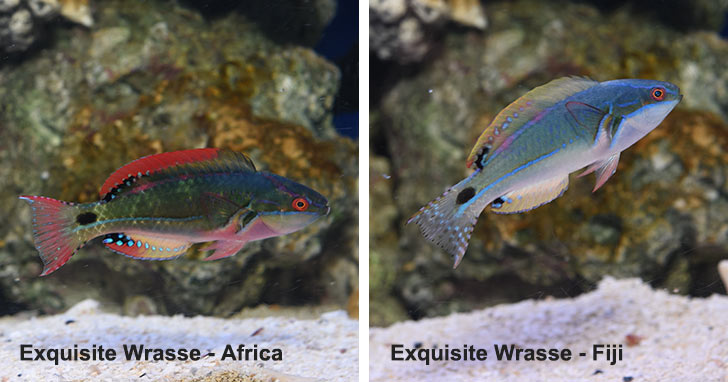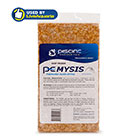Pencil Wrasse of the Genus Pseudojuloides
Pencil (Wrasse) Art The infrequent and limited availability further adds to the intrigue and mystique surrounding Pencil Wrasse of the genus Pseudojuloides, which currently recognizes more than a dozen species. All species of Pseudojuloides wrasse can be found in or near reefs, foraging in the sand, rubble and rubble-laden drop offs in search of benthic invertebrates to feed on. Pencil Wrasse Care and Husbandry First and foremost, let’s not forget that these splendors of the sea have been shipped from across the world after being collected, held at a collection station, then shipped to a wholesaler, who in turn ships to your online retailer of choice or local fish store. After such a tumultuous journey, it is critical to provide the best environment possible for your new addition. Knowing your newly acquired Pencil Wrasse has arrived to you after a series of potentially stressful events, it is paramount the fish is allowed to properly settle into a stress-free environment and routine to help with acclimation and conditioning to its new home. Tank mates, especially existing tank mates, need to be critically assessed ahead of time and chosen wisely as Pencil Wrasse will not fare well with established bullies and potentially aggressive fish such as Tangs, Triggers, Groupers, Damsels, Maroon Clownfish, etc. When stocking your aquarium, doing your research and homework in advance is key to successful acclimation of sensitive Pseudojuloides wrasse as well as other “Expert Only” fish. This point cannot be stressed enough. Some of these potentially aggressive fish listed can sometimes be introduced once the Pencil Wrasse has been introduced with success. In other words, the Pencil Wrasse needs to be established in the aquarium first before considering other compatible tank mates. Most Pencil Wrasse range in size from 3-1/2 to 5 inches so a moderate to large sized aquarium should be provided for these active swimmers. Said aquarium should also be mature and established with “live” rock with, at minimum, a 2 inch deep bed of “live” sand or soft substrate that will host amphipods and copepods for the wrasse to hunt and feed. Such natural food sources are extremely helpful if the wrasse is not yet fully-adjusted to frozen/thawed brine shrimp or mysis shrimp. The deep sand or substrate bed also provides shelter for the wrasse to burrow and hide in when needed. Feeding Pseudojuloides Wrasse As mentioned above live “pods” are a great way to elicit a feeding response in any wrasse since they are a natural prey item. Fortunately, wrasse feed on a diverse variety of items in the wild (such as polychaete worms, snails, crustaceans, etc.) making them prone to accept new or unfamiliar food items such as brine shrimp, mysis shrimp and other prepared frozen marine diets available for aquarists to purchase and offer their aquarium inhabitants. Another great offering for wrasse with a picky palate is live Bloodworms. Yes, one of the original freshwater fish feeding staples can entice a wrasse with its wiggling movement. When success is achieved feeding live blood worms you should be able to wean them over to frozen thawed blood worms until they expand their palate to other prepared items. Be sure to use a nutritional supplement like VitaChem a few times during the week when preparing fish food for optimal nutrition.
Cover Your Aquarium Pseudojuloides Wrasse Species Royal Pencil Wrasse (Pseudojuloides severnsi) is also known as Severn’s Pencil Wrasse. This bright and beautiful species can be found throughout the Indo-West Pacific from Indonesia, Sri Lanka and up to the Ryukyu Islands. Royal Pencil Wrasse are one of the more common Pencil Wrasse available in the aquarium industry. Male Royal Pencil Wrasse are slightly larger than females growing to approximately 4-1/2 inches. Males of this species display multiple colors and intensities depending on their color phase. Mature males display fuchsia to red markings on their nose which can run under the eyes and then stream past the gill covers to the mid-section of the wrasse. Overall body color is light green and muted on the underside. Mature males sport a large, dark blotch or “saddle” from the eyes to middle of its back on the upper half of the fish. From the mid-section back, the wrasse displays variations of blue/green and yellow horizontal stripes which end at the base of the blue to indigo colored tail fin. Female Pencil Wrasse are an overall orange color with yellow eyes and mostly transparent fins. Together, the male and female wrasse complement each other well and are deserving of the Royal name. 
Splendid Pencil Wrasse (Pseudojuloides splendens) is a relatively new species formally described by Benjamin Victor in 2017 in his review of the Indo-Pacific Pseudojuloides cerasinus complex which yielded two new species, Pseudojuloides polynesica, from French Polynesia and the Line Islands. The second new species, Pseudojuloides splendens ranges from Japan to Australia and across most of the South Pacific. It is now understood that Pseudojuloides cerasinus is only found around the Hawaiian Islands and was once thought to have a fairly wide range from the Izu Islands, Lord Howe Island, Austral Islands to Hawaii and East Africa. Pseudojuloides splendens is confined to the South Pacific, like the Royal Pencil Wrasse, Splendid Pencil Wrasse are one of the more common Pencil Wrasse seen in the aquarium industry when available. Splendid Pencil Wrasse can grow to approximately 4-3/4 inches in length with males being the larger of the two sexes. Mature male Splendid Pencil Wrasse are mostly green in overall color with two vivid light blue facial stripe markings, whereas, the Hawaiian endemic P. cerasinus, has only one. This bright blue color continues as a horizontal stripe down the middle of the fish extending to the base of the tail with a complimentary, yet contrasting yellow stripe running parallel along the bottom of the blue stripe. The tail fin starts out yellow in color and the back half darkens to black. The fins of the male Splendid Pencil Wrasse echo its body coloration but are slightly transparent in appearance. Female Splendid Pencil Wrasse are pastel pink to red in overall coloration. The female also displays a muted yellow color on the mouth, chin and eyes with mostly transparent fins. 
Kaleidos Blue Nose Pencil Wrasse (Pseudojuloides kaleidos) are slightly smaller than Small Tail and Royal Wrasse maxing out at around 4 inches. These magnificent Pencil Wrasse are only infrequently available in the aquarium industry making them one of the lesser known species among hobbyists. Kaleidos Blue Nose Pencil Wrasse are found in the Maldives and Indonesia. As their name implies, males of this highly coveted species boast a blue nose with green head while their top, or dorsal side is pink from above the eye to the tail. A dark band starts behind the green head to the tail where it fades out. The bottom half color of the fish is variation of light teal to green in color. 
Color and Pattern of Pencil Wrasse Wrasse coloration and pattern can also be affected by the locale or region from where they are collected. This is true for most species of wrasse. A prime example of variation in color within a species is the Exquisite Fairy Wrasse (Cirrhilabrus exquisitus). Exquisite Fairy Wrasse collected in Fiji are dramatically different in color from those collected in Africa. Exquisite Fairy Wrasse have a wide distribution with the many variations depending on their origin. 
We hope these shared techniques and information expand your palette in the care, appreciation and curating of the swimming artworks known as Pencil Wrasse. |
|||||
|
|








